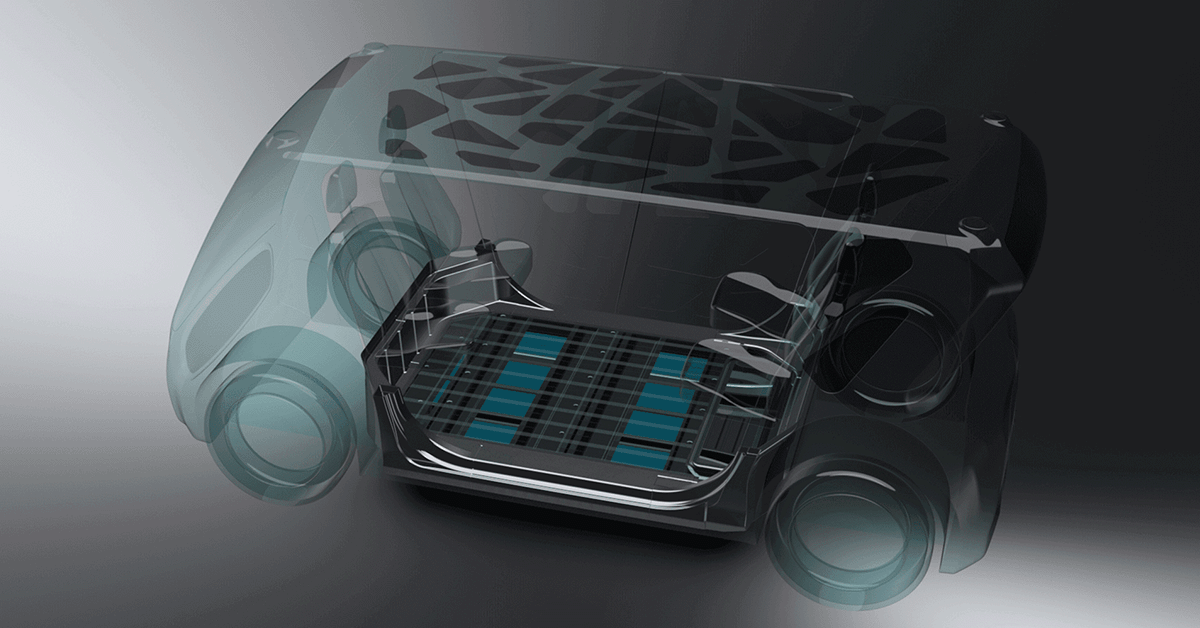Innovative high-voltage EV battery pack creates savings all round
Two vehicle concepts are being developed for the Steel E-Motive program, which is a collaboration between WorldAutoSteel and Ricardo; the smaller four passenger “SEM1” variant is intended for inner-city travel and the larger six passenger variant (SEM2) intended for longer inter-city journeys. The project demonstrates the suitability of the latest Advanced High-Strength Steel (AHSS) grades for use in a fully autonomous vehicle, engineered for a MaaS transport model.

The vehicles are conceptual and virtual. There are no plans to build vehicles, but the level of validation facilitates a prototype build. In coming months the engineering and validation phase of this autonomous vehicle design project will be complete and there will be a full reveal of unique engineering solutions, including the high-voltage EV battery module design. Here is a flavour of the some of the engineering battery module design decisions taken on the project.
An innovative EV battery pack-to-body framework
In conventional designs, they are inverted and suspended in a carrier frame. This frame is attached to the body-in-white structural cross members; a cover plate is then attached to the body in white that encloses and protects the battery pack. This gives significant mass and cost savings.
The EV battery packaging is engineered to enable a high level of compactness and energy density , allowing considerable mass reduction and improved safety performance, while meeting range targets. This design is also much more stiff and rigid, achieving target values for Noise, Vibration and Harshness (NVH). (The sounds and vibrations that passengers feel and hear in the vehicle as a result of the interactions of the powertrain, road noise and wind noise).
The mass of the battery can lead to its modal frequency being close to other modal frequencies which can lead to modal coupling and high (undesirable) vibration amplitudes. Improved NVH performance is achieved by designing the systems to have different resonance frequencies (modes) to other systems and away from the source and excitation frequencies.
Video demonstrates the assembly of the Steel E-Motive battery pack and how it integrates with the rest of the vehicle architecture
The EV battery pack designs-in safety and comfort
EV battery packs can fail due to issues with mechanical vibration, exposure to high-impact forces, such as crash events and thermal runaway (or a battery fire.) The enhanced Steel E-Motive mechanical battery package design minimises the risk of these issues occurring. The battery is protected by Advanced High-Strength Steel (AHSS) components, improving safety by preventing rupture of the battery in the event of a collision, which in turn protects passengers, occupants of other vehicles or pedestrians. The battery also is mounted in a higher position from the road than conventional designs, providing more road clearance to help avoid damage from debris.
The innovative mechanical design and packaging of the EV battery and its integration into the vehicle enables an improved floor design. The floor is completely flat with a lowered step-in height, making it easy for passengers to get in and out of the vehicle. The rocker encapsulates hex-shaped roll formed tubes made of suitable AHSS to achieve minimum body intrusion during side impact studies. In reviewing the design according to the Insurance Institute for Highway Safety (IIHS) standards and based on the predicted intrusions, we are confident this vehicle would achieve an IIHS “good” rating.
A more efficient and user-friendly design all round
The Steel E-Motive battery packaging makes it lighter, stiffer, stronger, easy to service and more cost efficient. The battery is assembled in a different sequence to the standard manufacturing process. However, feasibility studies have shown that any major disruption is avoided and the vehicles could be easily made on an existing production line.
The battery pack is designed to be chemistry and cell agnostic. There are many different types of battery cell and chemistries. Our goal is to ensure our vehicle packaging can accommodate a variety of cell or battery types, including fuel cells.
The vehicles are designed with servicing and repair in mind due to high vehicle uptime; deployment in a MaaS transport model requires continuous daily use with minimal downtime. The aim is to make it easier to service the battery and gain access to the main service points, such as the cooling and washer fluid containers.
The battery carrier frame has been designed to drop out of the body, with the modules, cooling system and power distribution unit all contained, at a MaaS service centre. The aim is to make it easier to service the battery, gaining quick access to the maintenance items if a fault is detected. The HV technician can easily access the power distribution unit for further diagnosis if required. This minimises the time and reduces cost to service the vehicle.
Find out more
Next steps in validation of the Steel E-Motive concepts include finalising detailed design elements of the battery frame and covers, and optimizing performance against road jacking and debris for the bottom cover.
Steel E-Motive engineering and validation will be completed this year, at which time we will prepare to deliver design concepts and final results. Stay on our journey as we will be revealing more of the engineering decisions and solutions between now and the end of the year. To stay in touch with webinars, technical publications, and conferences where we will present emerging information, be sure to subscribe.
Learn more about the Steel E-Motive vehicle design.
Keep up to date with news about the project.
Subscribe for updates
The Steel E-Motive vehicle concept is still in development. Sign up to be the first to hear about the latest developments from the program.
You might also be interested in
